Organic Fire on the Mountain
It’s no secret that the Emerald Triangle, in Northern California, has been the reigning champ of cannabis production in the United States for decades. However, with the advent of legal recreational pot in California, the rules of the game have changed. Growers are now forced to comply with legalization restrictions while hopefully not losing sight of what should be the goal—growing great pot. For many of us, this is a breath of fresh air, literally, as chemical fertilizers and pesticides will no longer fly thanks to lab testing. If you’re new to farming or transitioning from nonorganic farming practices, growing organically is the highest ideal a farmer can strive for. It’s essentially replicating the soil biology in the natural world around us, but in our garden beds. From developing good soil and fertilizers to harvesting and trimming for quality hash production, we’ll share some secrets and tips on how a couple of mom-and-pop operations are still getting it done the organic way.
About an hour outside the town of Willow Creek, up one of the many long dirt roads and perched on a boreal-forest ridge, sits Love and Laughter Farms. The farm is an impressive tract of forested land that rises from a creek and valley to a craggy mountaintop, and it is home to black bears, cougars and fishers. Old-growth Douglas fir and madrone surround the two gardens that sit high atop the mountain at an impressive 3,900 feet.
Love and Laughter was founded by Stephen DiTuro and his partner, Brianne Aalders, as a small medical farm in the late 2000s. With backgrounds in chemistry, environmental engineering and herbal medicine, the couple have always aimed at producing medical-grade full-sun flowers with a respect for sustainable practices. Now almost a decade later, the crew at Love and Laughter is navigating the waters of legalization, including the emerging recreational market, and learning to embrace California’s new regulatory landscape.
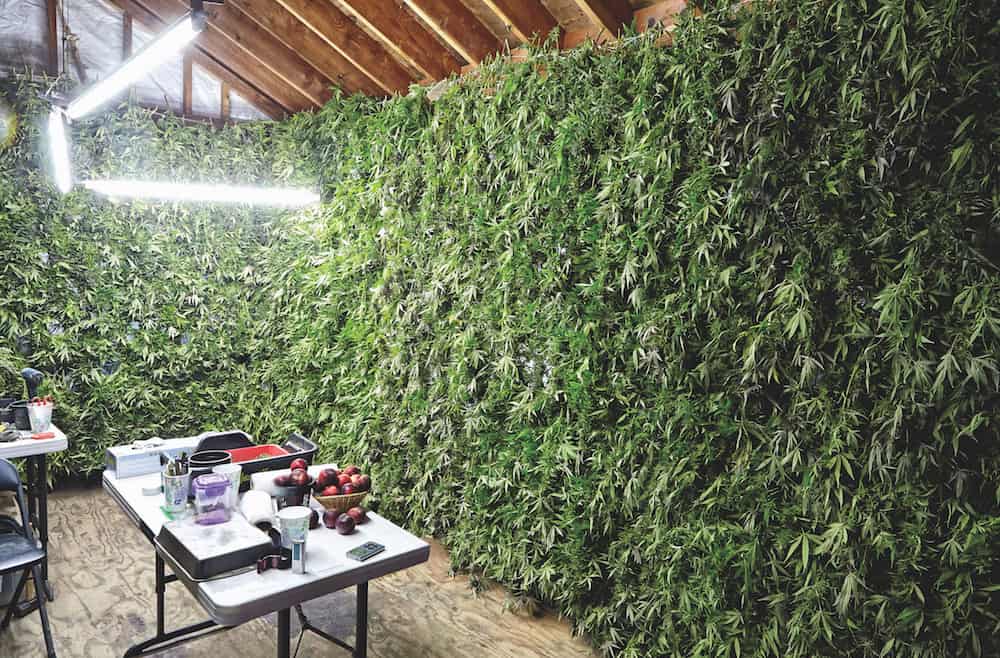
The Soil Is Everything
One can spend a lifetime reading about soil—and if you’re a farmer, you should. For those embracing legalization and organic growing methods, proper soil development begins with knowing what you’ve got. Whether you’ve just had your first load of soil dumped or you’re an experienced grower with established beds, you should have a soil sample tested by a local soil-testing lab.
Through the analysis, the lab establishes the pH balance, nutrient content, fungal and bacterial count, and soil composition. This is especially important if the soil might have had chemical fertilizers and pesticides running through it in the past. Many of those compounds are insoluble, or they break down extremely slowly, and can stick around for many years. Even clone stock from mother plants that were treated with conventional fertilizers and nonorganic pest-management products can introduce contaminants into a grow site, which can lead to a dirty test at market time.
If you’re pretty sure that your beds are clean and want to forgo the soil test, an electric soil or electrode meter, available at your local hardware store, is highly recommended to help dial in your pH. pH levels are the key to unlocking a plant’s ability to synthesize the provided nutrients. For outdoor growing, the soil pH should ideally be in the range of 6.4-6.8. All too often, nutrient deficiencies in the growth cycle can be traced right back to a pH imbalance.
There are essentially two kinds of outdoor growing styles when it comes to garden beds: aboveground or in ground, or, to put it in grower parlance, pots or trenches. Both have their pros and cons, but trench beds can be developed over time. The idea is to have soil that consists of the necessary components of organic matter, minerals, air and water, but also contains a healthy mix of bacteria, fungi and worms. Essentially, it’s the creation of a whole permaculture environment in the growing beds that, if properly maintained, will give back to the plants year after year.
The key minerals or macronutrients for marijuana are nitrogen, phosphorus and potassium, or NPK. Nitrogen helps spur growth and photosynthesis in the plants’ vegetative cycle. Initially during this phase, the nitrogen level in the fertilizer should be raised, as the plants will require more of it as they grow through the summer. Phosphorus is needed for nutrient uptake, and it also has its part in the vegetative cycle, but it’s usually associated with flowering. Initially during the vegetative stage, phosphorus levels should remain lower.
As flowering approaches, nitrogen should be dialed back and phosphorus and potassium levels increased. Sometimes overlooked, potassium takes care of the plant’s roots, metabolism and immune system. During flowering, phosphorus and potassium will be the driving force in flower or bud production. The amount of phosphorus and potassium used during this time has a direct impact on the growth and final size of the buds.
Dry and liquid amendments, including compost teas, should be used as organic fertilizers. Dry amendments, which are used as a general fertilizer and soil conditioner, are more insoluble and break down slowly over time. Compost teas are like a quick hit, and because they are soluble or water-based, the plant will be available to synthesize or use the nutrients more quickly. Both types of amendments can be used on a schedule throughout the season, but the teas should be used to quickly correct for deficiencies or to add small amounts of nutrients at different stages of the growth cycle when nutrient requirements change.
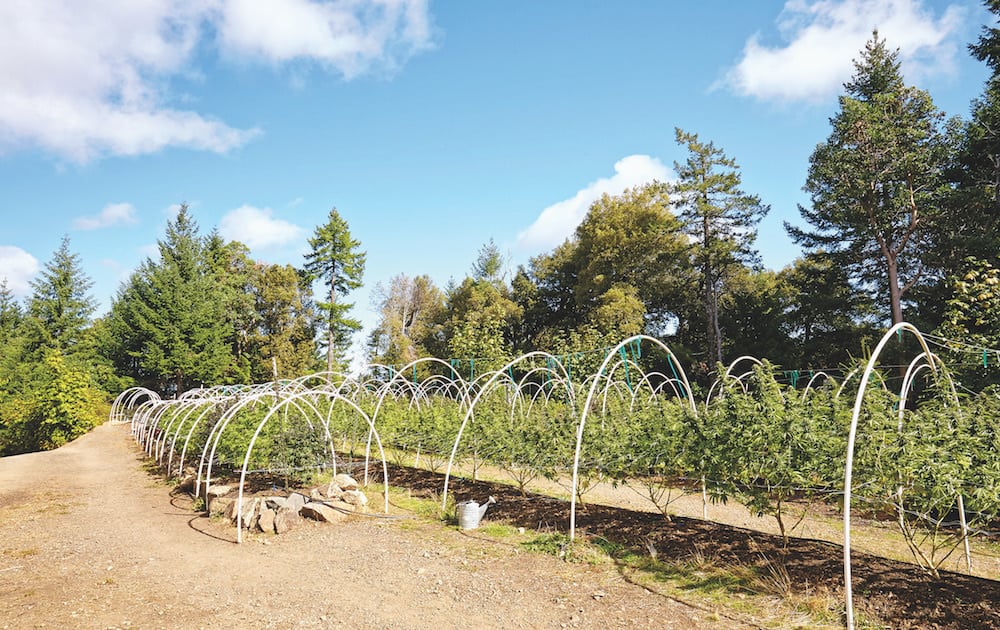
So How Do They Do It?
The foundation of Love and Laughter’s soil begins with a growing method called Hügelkultur, or “hill mound,” which is kind of a mix between the in-ground and aboveground methods. Hügelkultur is an ancient practice, used by many native peoples around the world, but it gained its most recent popularity through farmers in Germany and Eastern Europe. The basic idea of Hügelkultur is to bury wood and other organic plant material in a trench beneath the growing bed. Soil and other nutrient compounds are then added and mounded slightly above the existing ground level. As the wood matter slowly rots underground, it creates a long-term source of nutrients rich in nitrogen, increases water retention, helps aerate the soil and produces heat that will keep roots happy as fall temperatures drop during the flowering season.
For the gardens at Love and Laughter Farms, Hügelkultur was implemented in a big way. For the bed rows, five-foot-wide trenches were dug five feet deep, then filled with various types of oak (except for black oak, which has excessive toxins in its acorns). After the wood and leaf matter were placed at the bottom of the trench, organic mushroom soil, loaded with earthworms, was added on top of the wood base. Next, mealworm castings from an organic avocado farm in Southern California were mixed into the mushroom soil. Finally, a 50/50 mix of organic compost and potting soil, from a local landscape supplier, was added on top—just the tip of the iceberg of the Hügelkultur trench. The soil was then mounded over with the peak of the bed sitting about 16-20 inches above ground level. As the plant matter underneath decomposes with the help of proper amendments, the soil is rich in life and singing.
In the spring, the beds are weeded of their winter ground cover of alfalfa. Love and Laughter Farms practices a “no-till” method of farming. This means that other than the removal of the ground cover, there’s no root-ball removal or yearly tillage of the soil as is commonly practiced in modern commercial and home farming. After the harvest, stalks are cut as close to the soil surface as possible. By not disturbing the soil, healthy bacteria, fungi and worms are not harmed and allowed to flourish.
Put Them in the Ground
After the beds have been prepped and fertilized, and the proper spacing has been determined, the plants are ready to go in the ground. For each plant, a hole four times the size of the root-ball is dug out of the beds. The soil is saved and mixed with composted goat manure, mealworm castings, mushroom compost and mycorrhizal powder. This will surround the plant with an added mix of bacteria and fungi along with what’s already present in the soil. The manure is composted before being directly applied, which removes excessive ammonia and nitrogen levels that can burn plant roots, and it also kills grass seeds that are still alive in the manure, saving the farmers many hours’ worth of weeding and nutrient loss to pesky weeds. Once the plants are in the ground, they’ll receive only water for the first week or so as the roots establish themselves.
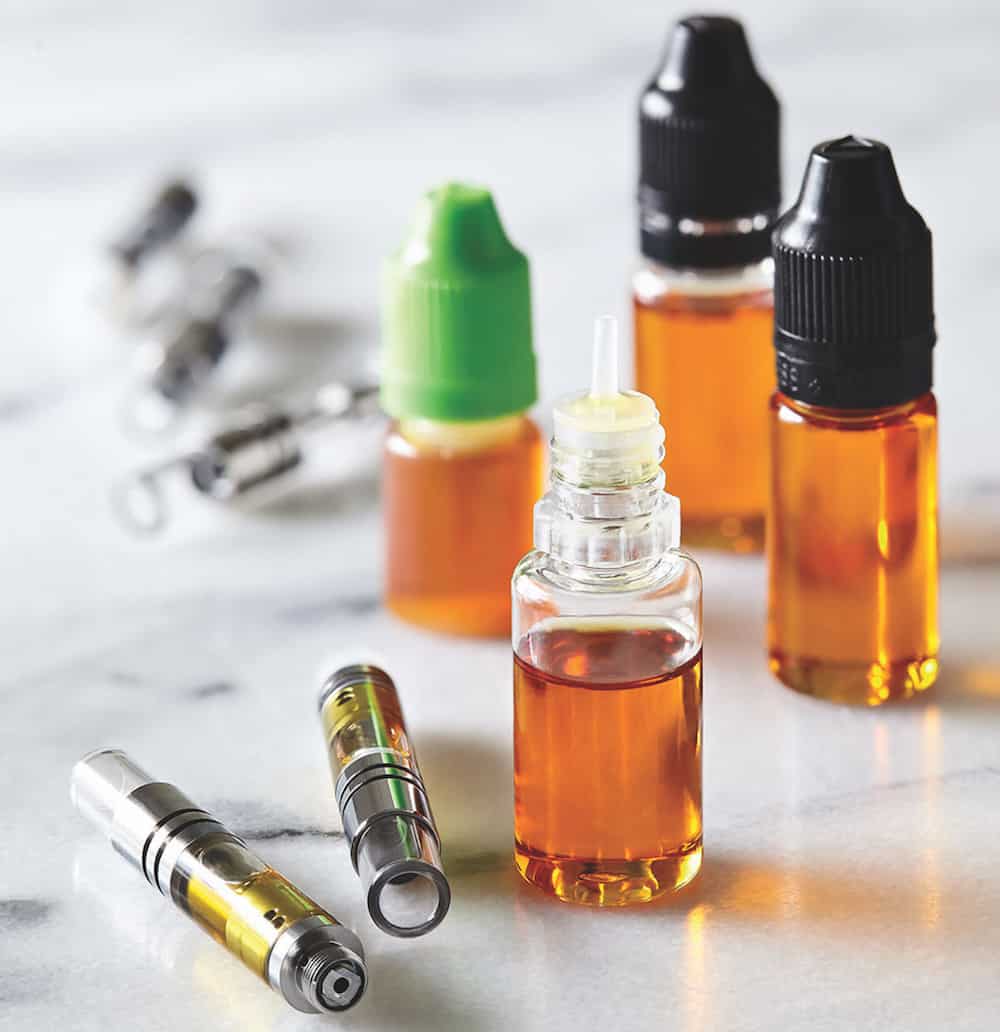
The Magic of Tea
As the roots take hold and the young plants begin to grow, custom compost teas are introduced into the feeding regimen. Although there’s a wide variety of great concentrated premixed solutions on the market, Love and Laughter Farms’ custom tea consists of, but is not limited to, bat guano, earthworm and mealworm castings, yucca extract, silica, bacteria, fungal spores, bone meal, oyster shells, dolomite lime, fish concentrate and emulsion, seaweed powder and molasses, which is a chelating agent. The compost tea is brewed in 60-gallon pickle barrels in the shade for 24 hours at an ideal temperature of 72°F. Aeration with a standard aquarium pump and air-stone diffusers produces oxygen supersaturation. When the tea is done, it’s hand-watered into the plant wells through a standard inline feeder, usually a quart dispersed throughout 150 gallons of water.
Initially, the tea is richer in nitrogen, but a couple weeks before flowering begins the nitrogen is dialed back and a higher-phosphorus bat-guano solution is maintained. Some people like dialing the nitrogen way back, but Love and Laughter actually keeps it somewhat high. This keeps the plants stronger and more disease- and pest-resistant throughout the plant’s natural life cycle.
Prune Her for Production
There are many techniques out there for pruning marijuana for higher yields. The preferred method at Love and Laughter is a technique called bending. The structure of the plants will vary depending on whether they’re indica- or sativa-dominant and how far along they are, but essentially young plants will have a main stem referred to as an apical meristem and then sub-stems called laterals. Traditionally, growers cut main or apical meristems, from which several more meristems will grow. These additional stems are the key to creating larger colas versus one main cola on an unpruned plant.
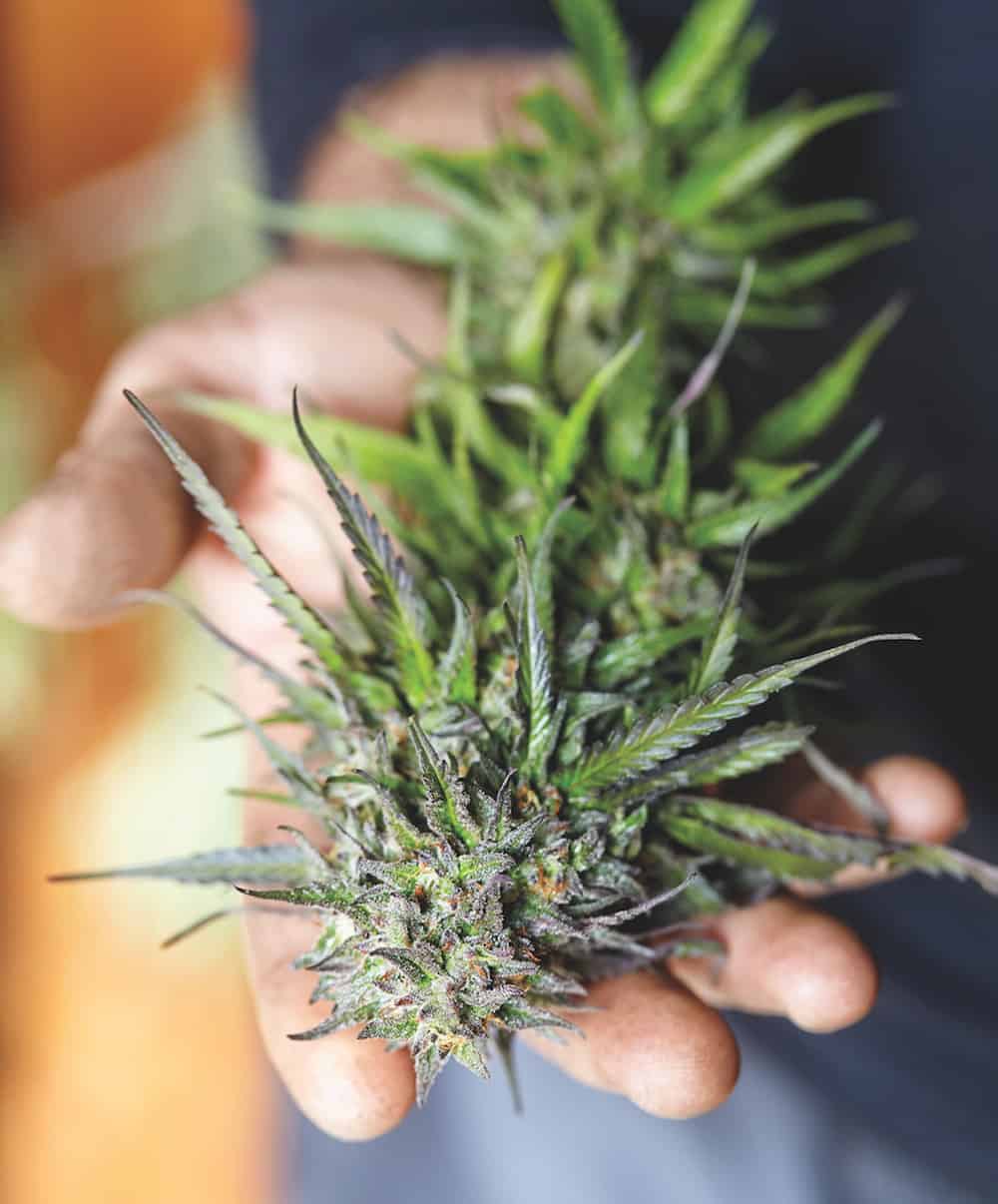
Cutting, however, can stress the plant for sometimes up to a week or more. By bending the main stem 90 degrees 7-10 days after the young plants are in, auxiliary growth points are created. And from this auxiliary growth point, several more meristems will begin to grow (eventually forming additional colas). This process is ideally repeated three or four times over the vegetative cycle, but should be completed a couple weeks before flowering begins.
Another important aspect which falls under pruning is defoliating. Yellow leaves will develop on marijuana plants for a variety of reasons, but the most common are due to nitrogen deficiencies, overwatering, a pH imbalance or shock from cold weather. It’s easy to correct for these problems, but leaves that have begun to die are removed before they start to mold.
Another defoliating technique that increases yield is the selective removal of fan leaves throughout the plant. This creates better airflow and allows more light into the inner and lower canopy, which in turn creates larger buds in places that might usually end up with larf (spindly lesser buds). By paying attention to the plants throughout the day, farmers can see which ones receive less light and remove those selectively. Lastly, if the bottom third of lower branches are removed (which usually produce larf anyhow), a plant will divert its energy up to the apical buds. This results in healthier colas and bigger yields.
Flush Away
A common mistake that novice growers make is improperly flushing before the end of flowering. Flushing helps the weed burn cleaner and improves aroma and flavor. Different strains, even different phenotypes of a same strain, will have different flowering times. By knowing the flowering time of the strain you’re growing, you can subtract two weeks from the total flowering time. Also, paying attention to the trichomes will help as well. If they look big and sticky but are still clear, it’s a good point to stop fertilizing. Love and Laughter harvests when about half of the resin glands have turned from milky to amber. During the last two weeks, a good trick is to flush by alternating between water alone and water mixed with humic acid, fulvic acid and molasses. This mixture will help break down the remaining insoluble fertilizer still in the soil and stems.
Golden Ending
Until very recently, many farmers discarded their trim and waste material. But in a short time, this material has become a sought-after commodity for those with knowledge of extraction techniques. While nugs may yield the most flavorful concentrates, hand trim and even machine trim can be more valuable to an extractor’s bottom line.
Take a half day’s drive down Highway 101 to Route 1, at Monterey Bay, and you will find an enclave of cutting-edge extraction artists. Among them is John Ollila of Santa Cruz Concentrates and Hushpuff. An early adopter of CO2 extraction, Ollila is fighting the wave of investment dollars pouring into many large hydrocarbon labs that are tanking concentrate prices in parallel with what farmers have experienced with flower rates in recent years.
Love and Laughter Farms provides properly cured, organic, pesticide-free trim that is ideal for supercritical CO2 extraction. Raw material is sorted for remaining stems and fan leaves before being vacuum-sealed to preserve terpenes. While many manufacturers start with fresh frozen material to achieve a “live resin” or “sauce,” this is only a viable option for solvent-based extractions—mainly butane, though ethanol extracts are on the rise. California has always frowned on hydrocarbon (butane and propane) extractions because of the risk to public safety, and it should be noted that this is still an illegal practice without a local hazardous-materials license and applicable state license. The rest of us are allowed to use CO2, ethanol, water, manual press and sifting techniques.
Properly cured trim will be free of excess water, which is detrimental to most of the above-mentioned techniques. Using a liquid CO2 extraction machine fabricated by Paradigm Supercritical Innovations of Springfield, Oregon, Santa Cruz Concentrates prefers to operate extraction chambers at roughly 2,700 psi and 100°F. Ollila’s unit, named Lucy, is powered by a 15-horsepower compressor that keeps the flow rate high. It takes roughly 7.6 liters of supercritical CO2 to extract one gram of THC, so patience for this process is necessary while being limited to processing a maximum of 101 pounds in a 16-hour day.
Many turnkey CO2 systems that allow an operator to walk away and return a day later to a completed extraction cycle run upward of 4,500 psi and 130°F; while this will allow for a more complete extraction of cannabinoids, it also pulls many impurities that decrease the initial potency of the extract and make it more difficult to achieve maximum oil potency after refinement. There are, of course, solutions to any problem if you have deep enough pockets. Wiped-film units are becoming increasingly common, and, similar to turnkey CO2 systems, they allow operators with little or no chemistry knowledge to hop in the game and refine crude oil to shockingly potent distillate.
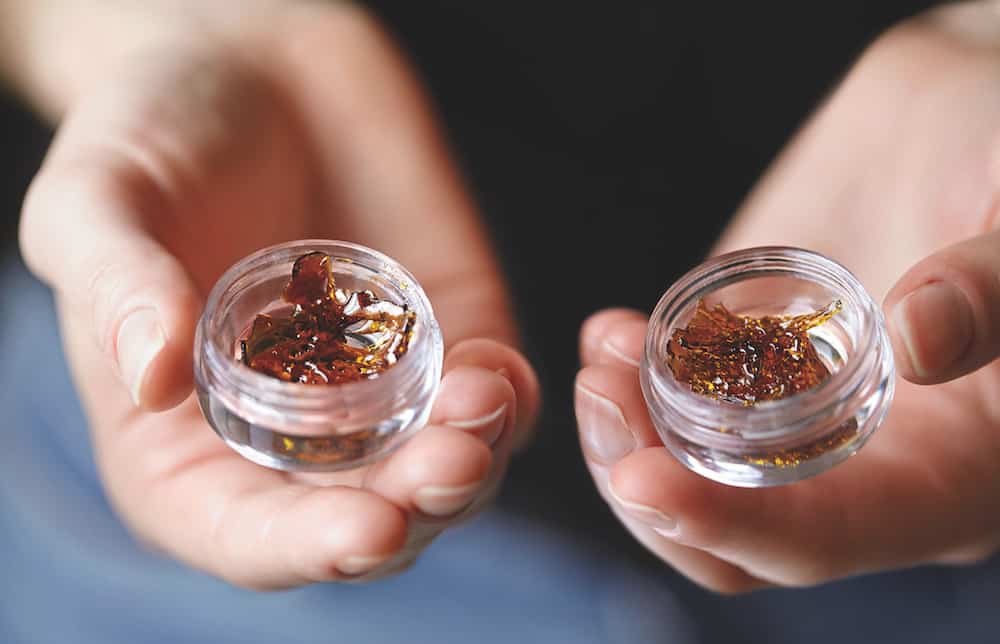
Clean Oil
Here on the Central Coast, Santa Cruz Concentrates does it the old-fashioned way. Supervised by an intelligent chemist, the short-path distillation of a properly dewaxed and bleached CO2 extract yields just as potent oil as a wiped-film unit running crude B/PHO. Pressures and temperatures on the lower end of the supercritical spectrum during extraction also allow Santa Cruz Concentrates to achieve a shatter with no additional post-processing required other than a few hours in a vacuum oven to remove residual water content. And in an exciting move to more accessible cannabis-derived terpenes, innovation continues further as Paradigm has just provided an in-line terpene trap to add to its extraction units.
With all the dollars flooding into this industry with the goal of mass-producing marijuana vaporizers, Santa Cruz Concentrates is just fine with being a micro-brew, proud to source from small organic farmers, like those at Love and Laughter Farms, who take pride in their process.
Patients and recreational users should be encouraged to be picky about what they inhale; while our lungs may be able to take some hits, they are very sensitive and, especially in a smoker’s life, often the most susceptible to compromise by heavy metals or carcinogenic pesticides. Know your grower and your extract artist. Demand test results. Be very wary of bottom-dollar extracts. And #puffon.
This feature was published in the November 2018 issue of High Times magazine, subscribe right here.















It is a shame the reporter Stout didn’t ask the important question of DiTuro and Aalders. How often are the Bigfoots coming to visit? Are they taking a share? Are you leaving apples and fruit out for them? Enquiring minds…